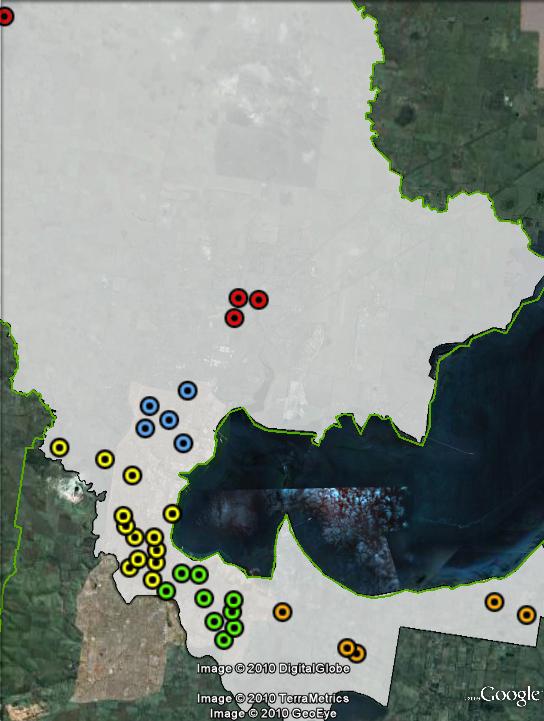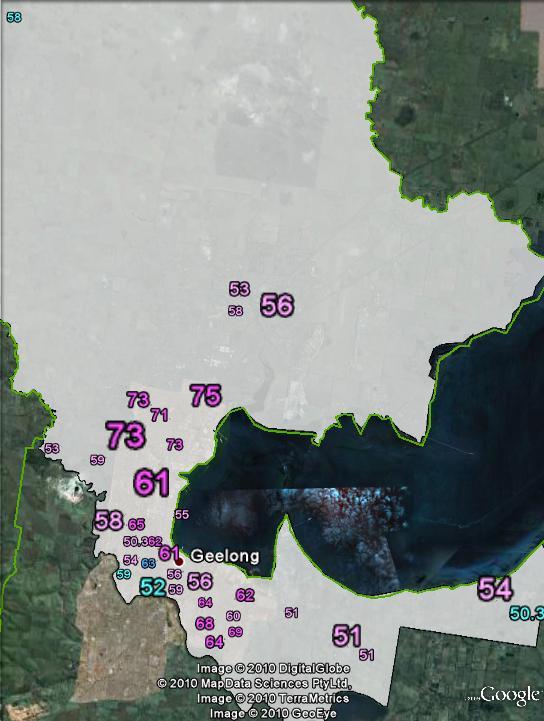ALP 8.9%
Incumbent MP
Richard Marles, since 2007.
Geography
Geelong and surrounding areas. Corio covers most of the Geelong urban area and those parts of the City of Greater Geelong north of the centre of Geelong. The seat also stretches along part of the north coast of the Bellarine Peninsula.
History
The seat of Corio is an original federation seat. It was originally a marginal seat, switching between conservative parties and the ALP, but since the 1970s it has become a relatively safe Labor seat.
Corio was first won in 1901 by Richard Crouch, a Protectionist candidate and the youngest member of the first Parliament. He was re-elected in 1903 and 1906 before losing in 1910. He later returned at a much older age to hold the neighbouring seat of Corangamite for the ALP from 1929 to 1931.
Corio was won in 1910 by the ALP’s Alfred Ozanne. He lost in 1913 to Liberal candidate William Kendell, but won the seat back in 1914. Ozanne lost again in 1917.
The seat was won in 1917 by Nationalist candidate John Lister. He held the seat for the next decade, losing in 1929.
The seat of Corio was won by Labor candidate Arthur Lewis in 1929, but he only held it for one term before losing to the United Australia Party’s Richard Casey.
Casey joined the Lyons ministry in 1933, and became Treasurer in 1935. When Robert Menzies became Prime Minister in 1939, he saw Casey as a rival for the leadership, and moved him into a lesser role, before appointing him as Ambassador to the United States. Casey played a key role in cementing Australia’s alliance with the United States in the Second World War.
He returned to Parliament as Member for La Trobe in 1949, and served as a key minister in the Menzies government until his appointment as a member of the House of Lords in 1960. He also served as Governor-General from 1965 to 1969.
The 1940 Corio by-election was won by the ALP’s John Dedman. He was appointed to the ministry upon the formation of the Curtin Labor government in 1941, and served in a key role in the War Cabinet. He was particularly responsible for war production, post-war reconstruction and the creation of the Commonwealth Scientific and Industrial Research Organisation (CSIRO). He lost Corio in 1949 to Liberal candidate Hubert Opperman.
Opperman had been a prominent Australian cyclist, and had rode in the Tour de France on a number of occasions. He served as a Cabinet minister from 1960 to late 1966, before leaving Parliament in 1967 to serve as High Commissioner to Malta.
The 1967 Corio by-election was won by the ALP’s Gordon Scholes. Scholes was elected Speaker of the House of Representatives in early 1975 after the resignation of his predecessor after a disagreement with the Whitlam government. Scholes served in the role for the remainder of the Whitlam government. He served as a minister in the Hawke government from its election in 1983 until 1987, and retired in 1993.
Corio was won in 1993 by Gavan O’Connor. He joined the Labor frontbench in 1998 and served on the role until 2007. In 2006 he was challenged for preselection by ACTU Assistant Secretary Richard Marles, who won. O’Connor ran as an independent for Corio in 2007, but polled a distant third.
Since winning Corio in 2007, Marles served on the backbench until he was appointed as a Parliamentary Secretary in 2009.
Candidates
- Gavin Brown (Greens)
- Sue Bull (Socialist Alliance)
- Richard Marles (Labor)
- Scott Amberley (Family First)
- Don Gibson (Liberal)
Political situation
This seat has now become relatively safe for the ALP, as they held on to it through the entirety of the Howard government. It would only be vulnerable in the case of a Liberal landslide.
2007 result
| Candidate | Party | Votes | % | Swing |
| Richard Marles | ALP | 37,778 | 45.49 | -1.19 |
| Angelo Kakouros | LIB | 24,591 | 29.61 | -10.68 |
| Gavan O’Connor | IND | 10,530 | 12.68 | +12.68 |
| Rob Leach | GRN | 4,910 | 5.91 | +0.00 |
| Gordon Alderson | FF | 3,291 | 3.96 | +1.37 |
| Darrin Welden | LDP | 791 | 0.95 | +0.95 |
| Erica Menheere-Thompson | DEM | 628 | 0.76 | +0.76 |
| Chris Johnson | SA | 332 | 0.40 | -0.23 |
| Ross Russell | CEC | 190 | 0.23 | -0.08 |
2007 two-candidate-preferred result
| Candidate | Party | Votes | % | Swing |
| Richard Marles | ALP | 48,939 | 58.93 | +3.29 |
| Angelo Kakouros | LIB | 34,102 | 41.07 | -3.29 |
Booth breakdown
Booths in Corio have been divided into five areas. Booths in the Geelong urban area are divided into West and Central. Booths along the peninsula have been grouped as ‘East’, with northern parts of the seat grouped into Corio-Norlane, in the area closest to Geelong, and ‘North’, covering those areas further away from Geelong.
The ALP won a majority in all area, but these varied wildly. The ALP won over 73% in Corio-Norlane and over 61% in central Geelong, with between 52% and 56% in the other parts of the seat.

| Voter group | GRN % | ALP 2CP % | Total votes | % of votes |
| West | 6.63 | 56.00 | 22,096 | 26.61 |
| Central | 6.46 | 61.73 | 13,444 | 16.19 |
| Corio-Norlane | 3.45 | 73.18 | 12,822 | 15.44 |
| East | 5.65 | 51.86 | 11,166 | 13.45 |
| North | 5.31 | 54.95 | 7,199 | 8.67 |
| Other votes | 6.87 | 56.01 | 16,314 | 19.65 |



I think you’re underestimating the safeness of Corio for Labor based on its past results. Corio these days is as solid Labor territory as they come. It’s easy to look the history and assume it’s theoretically winnable for the Liberals, but they’ll never come within cooee of it again. These days, it falls into a similar category to Fremantle – couldn’t fall even in a worst-case scenario.
It really should have been classed as safe Labor since the 1940s – Hubert Opperman held the seat for so long because a) he was one of the most “star” star candidates ever to run for the House, and because he was an incredibly well-regarded local member – my staunchly Labor family still holds him in very high regard.
Rebecca,
You may be right, I don’t know the area that well, but I was basing it more on the margin (8.9%) rather than the seat’s history.
Opperman’s success partially reflected his personality, but also the weakness of Dedman as a candidate in 1949 (even though he was an outstanding minister) but mostly the fact that the 1960s were very bad years for Victorian Labor. Corio has an inner-city left vote but the Labor heartlands to the north are ageing, in the long run expect the Liberals to improve their vote in the north.
My prediction: This does seem as though it should be much safer for Labor, perhaps O’Connor hurt the Labor vote in 2007 – his prefs split 50-50 between Labor and the Libs. I’d say 4-5% swing to Labor.
It was over 60% Labor back in the 1980s so I agree the 2007 vote looks a bit low.